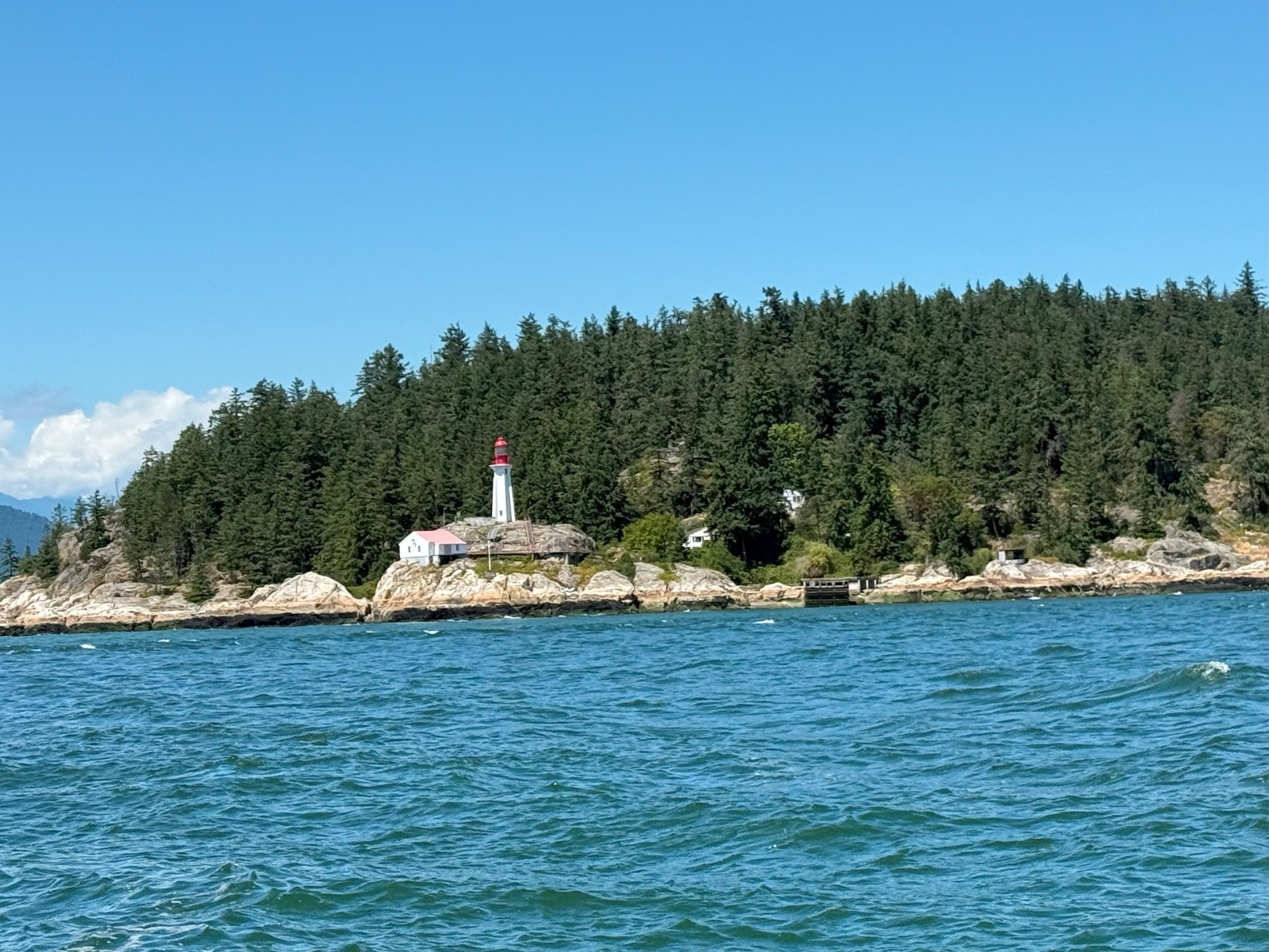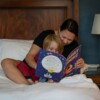As I write this post, our sailboat is tied up in a small public marina in British Columbia, twenty-five nautical miles north of the city of Vancouver, on a sunny weekday morning. However, just outside the harbor, twenty-knot winds with forty-knot gusts are whipping up three-foot whitecaps, and even in the harbor, our boat is being tossed around like a yellow rubber ducky in a bathtub rapidly filling with water. It’s not much fun being jostled in every direction, but we’re safe. This unusual summer wind is expected to die down in a few hours, and we’ll likely be safely on our way later this afternoon.
Sitting in the cabin while the boat bucks against the dock, I’m reminded of a poster that once hung on my teenage bedroom wall—a grainy photo of a schooner under full sail, with the caption: “A ship in harbor is safe, but that is not what ships are built for.” One of many mass-produced inspirations of that era, they urged young dreamers to take risks, live boldly, hang in there, choose joy, fall in love, and “be all you can be”– well, you get the picture. Possibly, you had one or more such posters in your childhood bedroom, too.
By that logic of my childhood, perhaps my husband and I should be more adventurous—cast off the lines, point the bow into the wind, and at least motor to our next stop. After all, the waves out in Canada’s Strait of Georgia probably aren’t much rougher than the relentless rocking we’re already enduring in the marina. But there’s a catch: just south of us lies Shoal Channel, a stretch that becomes dangerous at low tide or in high winds. And right now, we have both.
A shoal forms when two bodies of water converge, stirring up underwater sediment and turning what appears to be a navigable channel into dangerously shallow water. Without experience—or a careful reading of nautical charts—sailors might not know it’s there until it’s too late. That may well have been the case in Acts 27, when the Apostle Paul was shipwrecked off the island of Malta. Luke tells us the ship ran aground just before reaching the bay. Some translations describe the obstruction as a reef, others as a sandbar or shoal—but in any case, it was unseen shallows that caught the bow. The stern was then broken apart by waves crashing from behind. Those who survived did so by swimming or clinging to wreckage that carried them ashore.
Yet, this wasn’t some freak accident on an otherwise well-planned voyage. Fourteen days earlier, Paul warned the ship officers not to sail because it was late fall after The Fast (e.g., Day of Atonement), and they were entering the stormy season. He cautioned that pressing on could mean losing cargo, the ship, and even lives. But instead of listening to Paul—or trusting their own maritime experience—the crew bet on reaching Crete before the wintry conditions worsened. Even without 20-20 hindsight, the wiser choice would have been to heed Paul’s advice.
What Paul advocated in that moment wasn’t based on fear or indecision—it was prudence. One of the cardinal virtues, prudence, is the wisdom that guides practical decision-making. 1 But it’s also a form of critical thinking: the ability to weigh competing outcomes, judge their moral significance, and choose the most virtuous course of action. As a cardinal virtue (from the Latin cardo, meaning “hinge”), prudence connects to other virtues. It may require courage to act amid uncertainty or forbearance when restraint is wiser. In Acts 27, Paul displayed just this kind of critical discernment—evaluating risk, anticipating consequences, and urging his ship officers to stay in harbor rather than press on into danger.
This broader view of prudence as critical thinking invites us to reconsider what we often mean by that term. Typically, we associate critical thinking with evaluating content—grappling with epistemic questions about truth, evidence, and the distinctions between fact, opinion, and belief. We emphasize epistemic virtues like intellectual humility, which fosters a willingness to question not only what we know, but how we know it. The humanities, at their best, cultivate this kind of thoughtful inquiry, forming habits of mind that support both truth-seeking and humble self-awareness.
But prudence also depends on another aspect of critical thinking: practical reasoning—the ability to make sound decisions under uncertain conditions. Here, the social sciences offer indispensable tools. The scientific method and statistics provide structured ways to define problems, identify independent and dependent variables, and calculate odds associated with uncertainty and confidence. We may not have complete data for every situation or person, but the scientific method equips us to collect reliable, valid, and generalizable information that supports reasoned and actionable decisions.2 While the humanities and theology help us discern what is worth pursuing, the social sciences help us understand what pursuing those goals will require. In this way, prudence—whether Paul’s or our own—draws from both forms of critical thinking: moral judgment and measured analysis.
Prudence, as a form of critical thinking, also requires us to recognize and resist the natural biases that cloud our judgment. The scientific method doesn’t only help us calculate statistical outcomes—it slows us down. It interrupts the cognitive shortcuts we’re prone to take and offers an external structure for clearer thinking. Two biases, in particular, often distort our decision-making. The first is overconfidence—our tendency to overestimate the accuracy of our judgments and the quality of our past decisions. Most of us think we’re better decision-makers than we actually are.3 The rigor of the scientific method disrupts this illusion by pulling us out of purely intuitive thinking and creating a structured and transparent process in which others can test and contribute to our reasoning.
The second is a bias toward action—especially common in leadership—where decisiveness is prized, and alternative scenarios or counterfactual evidence are easily dismissed. Here again, the scientific method plays a moderating role. Its insistence on defined variables, standardized data collection, and agreed-upon heuristics slows down impulsive thinking. It offers what Daniel Kahneman calls a shift away from “fast thinking” toward a more deliberative process.4 In this way, it serves prudence—not only helping us avoid errors, but also enabling us to make wiser decisions than our instincts alone might allow. It’s fair to say that the officers aboard Paul’s ship succumbed to both forms of bias: they relied on their own confidence, prioritized action, and ignored the voice of restraint.
Nearly 2,000 years after the Apostle Paul urged his ship’s officers to count the cost of sailing into danger, President George H. W. Bush made a similarly weighty decision. In 1991, at the close of the first Gulf War, he halted the Allied advance before pushing into Baghdad. “It wouldn’t be prudent,” he said—language that, though mocked at the time as overly refined or timid, reflected clear-eyed judgment. In everyday terms, prudence is often misunderstood as caution bordering on cowardice, a reluctance to act when boldness seems called for—as if it means staying tied up in harbor rather than braving rough seas. Bush’s restraint was cast in that light by critics, seemingly confirming Newsweek’s infamous 1987 cover story on his so-called “wimp factor.”5
But his decision was not driven by fear or indecision. Rather, it was rooted in the careful deliberation that marks true prudence. Together with his advisors and coalition partners, Bush assessed the risks and potential consequences of expanding the mission. The war’s original goal—to drive Saddam Hussein’s forces out of Kuwait—had been achieved. There was no clear mandate, nor strategic benefit, to justify escalating into regime change or nation-building. Instead of improvising new objectives to justify further aggression, he held the line. That choice—widely questioned at the time—had a profound personal consequence for me: because of his restraint, my father-in-law was safely home just six months after deploying.
Virtues like prudence and forbearance become second nature through practice. As a decorated World War II naval officer and lifelong mariner, President Bush likely learned prudence not only through his studies as an undergraduate at Yale but also cultivated it through habit. Seasoned sailors run through a mental checklist before every departure—waves, wind, weather, tides, fuel, battery, water—and once underway, they continually assess the risks and rewards of the journey. I like to think that Bush’s years at sea helped shape the steady judgment he brought to the storms of leadership: measured, deliberate, and anchored in restraint.
Critical thinking isn’t only about organizing facts into knowledge. It’s about cultivating the kind of character that makes wise decisions possible, including the wisdom to wait or refrain from acting altogether. Sometimes, prudence requires staying in the harbor even when everything in us wants to be out at sea.
Footnotes
- See Lanta Davis, “Personifying Prudence: The Face(s) of Wisdom,” Christian Scholar’s Review Blog (2024, June 25), https://christianscholars.com/personifying-prudence-the-faces-of-wisdom/
- Robert Abelson, Statistics as Principled Argument (Yale University Press, 1995).
- See David Dunning, Self-Insight: Roadblocks and Detours on the Path to Knowing Thyself (Psychology Press, 2012).
- Daniel Kahneman, Thinking Fast and Slow (Doubleday, 2011).
- Margaret Garrard Warner, “George H.W. Bush’s Greatest Campaign Challenge: Revisit Newsweek’s 1987 Cover Story, ‘The Wimp Factor’” Newsweek Magazine (2018, December 4): https://www.newsweek.com/newsweek-1987-cover-story-george-hw-bush-wimp-factor-1241611























